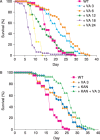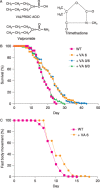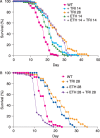Valproic acid extends Caenorhabditis elegans lifespan
- PMID: 18248662
- PMCID: PMC6838649
- DOI: 10.1111/j.1474-9726.2008.00375.x
Valproic acid extends Caenorhabditis elegans lifespan
Abstract
Aging is an important biological phenomenon and a major contributor to human disease and disability, but no drugs have been demonstrated to delay human aging. Caenorhabditis elegans is a valuable model for studies of animal aging, and the analysis of drugs that extend the lifespan of this animal can elucidate mechanisms of aging and might lead to treatments for age-related disease. By testing drugs that are Food and Drug Administration approved for human use, we discovered that the mood stabilizer and anticonvulsant valproic acid (VA) extended C. elegans lifespan. VA also delayed age-related declines of body movement, indicating that VA delays aging. Valproic acid is a small carboxylic acid that is the most frequently prescribed anticonvulsant drug in humans. A structure-activity analysis demonstrated that the related compound valpromide also extends lifespan. Valproic acid treatment may modulate the insulin/IGF-1 growth factor signaling pathway, because VA promoted dauer larvae formation and DAF-16 nuclear localization. To investigate the mechanism of action of VA in delaying aging, we analyzed the effects of combining VA with other compounds that extend the lifespan of C. elegans. Combined treatment of animals with VA and the heterocyclic anticonvulsant trimethadione caused a lifespan extension that was significantly greater than treatment with either of these drugs alone. These data suggest that the mechanism of action of VA is distinct from that of trimethadione, and demonstrate that lifespan-extending drugs can be combined to produce additive effects.
Figures






Similar articles
-
Pharmacology of delayed aging and extended lifespan of Caenorhabditis elegans.Exp Gerontol. 2006 Oct;41(10):1032-9. doi: 10.1016/j.exger.2006.06.038. Epub 2006 Jul 26. Exp Gerontol. 2006. PMID: 16872777 Review.
-
Anticonvulsant medications extend worm life-span.Science. 2005 Jan 14;307(5707):258-62. doi: 10.1126/science.1105299. Science. 2005. PMID: 15653505
-
Effects of anticonvulsant drugs on life span.Arch Neurol. 2006 Apr;63(4):491-6. doi: 10.1001/archneur.63.4.491. Arch Neurol. 2006. PMID: 16606760
-
The anticonvulsant ethosuximide disrupts sensory function to extend C. elegans lifespan.PLoS Genet. 2008 Oct;4(10):e1000230. doi: 10.1371/journal.pgen.1000230. Epub 2008 Oct 24. PLoS Genet. 2008. PMID: 18949032 Free PMC article.
-
A pathway that links reproductive status to lifespan in Caenorhabditis elegans.Ann N Y Acad Sci. 2010 Aug;1204:156-62. doi: 10.1111/j.1749-6632.2010.05640.x. Ann N Y Acad Sci. 2010. PMID: 20738286 Review.
Cited by
-
Ketone bodies as signaling metabolites.Trends Endocrinol Metab. 2014 Jan;25(1):42-52. doi: 10.1016/j.tem.2013.09.002. Epub 2013 Oct 18. Trends Endocrinol Metab. 2014. PMID: 24140022 Free PMC article. Review.
-
Current Perspective in the Discovery of Anti-aging Agents from Natural Products.Nat Prod Bioprospect. 2017 Oct;7(5):335-404. doi: 10.1007/s13659-017-0135-9. Epub 2017 May 31. Nat Prod Bioprospect. 2017. PMID: 28567542 Free PMC article. Review.
-
Phenotypic Screening in C. elegans as a Tool for the Discovery of New Geroprotective Drugs.Pharmaceuticals (Basel). 2020 Jul 25;13(8):164. doi: 10.3390/ph13080164. Pharmaceuticals (Basel). 2020. PMID: 32722365 Free PMC article. Review.
-
A triple drug combination targeting components of the nutrient-sensing network maximizes longevity.Proc Natl Acad Sci U S A. 2019 Oct 15;116(42):20817-20819. doi: 10.1073/pnas.1913212116. Epub 2019 Sep 30. Proc Natl Acad Sci U S A. 2019. PMID: 31570569 Free PMC article.
-
Divalproex sodium modulates nuclear localization of ataxin-3 and prevents cellular toxicity caused by expanded ataxin-3.CNS Neurosci Ther. 2018 May;24(5):404-411. doi: 10.1111/cns.12795. Epub 2018 Jan 9. CNS Neurosci Ther. 2018. PMID: 29318784 Free PMC article.
References
-
- Adachi H, Ishii N (2000) Effects of tocotrienols on life span and protein carbonylation in Caenorhabditis elegans . J Gerontol A Biol Sci Med Sci. 55, B280–285. - PubMed
-
- Ayyadevara S, Alla R, Thaden JJ, Shmookler Reis RJ (2008) Remarkable longevity and stress resistance of nematode PI3K‐null mutants. Aging Cell. 7, 13–22. - PubMed
-
- Balaban RS, Nemoto S, Finkel T (2005) Mitochondria, oxidants, and aging. Cell. 120, 483–495. - PubMed
-
- Bass TM, Weinkove D, Houthoofd K, Gems D, Partridge L (2007) Effects of resveratrol on lifespan in Drosophila melanogaster and Caenorhabditis elegans . Mech Ageing Dev. 128, 546–552. - PubMed
-
- Berdichevsky A, Viswanathan M, Horvitz HR, Guarente L (2006) C. elegans SIR‐2.1 interacts with 14‐3‐3 proteins to activate DAF‐16 and extend life span. Cell. 125, 1165–1177. - PubMed
Publication types
MeSH terms
Substances
Grants and funding
LinkOut - more resources
Full Text Sources
Miscellaneous

